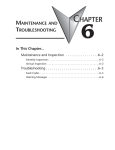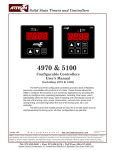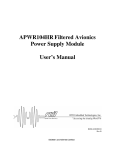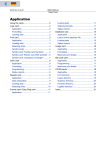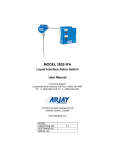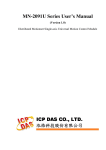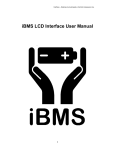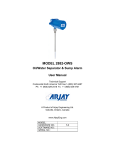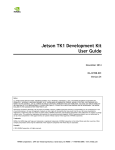Download Chapter 6 - AutomationDirect
Transcript
MAINTENANCE AND TROUBLESHOOTING CHAPTER 6 Contents of this Chapter... Maintenance and Inspection . . . . . . . . . . . . . . . . . . . . . . . . . . . . .6–2 Monthly Inspection . . . . . . . . . . . . . . . . . . . . . . . . . . . . . . . . . . . . . . . .6–2 Annual Inspection . . . . . . . . . . . . . . . . . . . . . . . . . . . . . . . . . . . . . . . . .6–2 Recharge Capacitors (for unused drives) . . . . . . . . . . . . . . . . . . . . . . . .6–2 Troubleshooting . . . . . . . . . . . . . . . . . . . . . . . . . . . . . . . . . . . . . .6–3 Fault Codes . . . . . . . . . . . . . . . . . . . . . . . . . . . . . . . . . . . . . . . . . . . . . .6–3 Warning Messages . . . . . . . . . . . . . . . . . . . . . . . . . . . . . . . . . . . . . . . . .6–5 Chapter 6: Maintenance and Troubleshooting Maintenance and Inspection Modern AC drives are based on solid state electronics technology. Preventive maintenance is required to operate the AC drive in its optimal condition, and to ensure a long life. We recommend that a qualified technician perform a regular inspection of the AC drive. Some items should be checked once a month, and some items should be checked yearly. Before the inspection, always turn off the AC input power to the unit, and wait at least two minutes after all display lamps have turned off. If the drive is stored or is otherwise unused for more than a year, the drive’s internal DC link capacitors should be recharged before use. Otherwise, the capacitors may be damaged when the drive starts to operate. We recommend recharging the capacitors of any unused drive at least once per year. WARNING! Disconnect AC power and ensure that the internal capacitors have fully discharged before inspecting the AC drive! Monthly Inspection: Check the following items at least once a month. 1. Make sure the motors are operating as expected. 2. Make sure the installation environment is normal. 3. Make sure the cooling system is operating as expected. 4. Check for irregular vibrations or sounds during operation. 5. Make sure the motors are not overheating during operation. 6. Check the input voltage of the AC drive and make sure the voltage is within the operating range. Check the voltage with a voltmeter. Annual Inspection Check the following items once annually. 1. Tighten and reinforce the screws of the AC drive if necessary. They may loosen due to vibration or changing temperatures. 2. Make sure the conductors and insulators are not corroded or damaged. 3. Check the resistance of the insulation with a megohmmeter. 4. Check the capacitors and relays, and replace if necessary. 5. Clean off any dust and dirt with a vacuum cleaner. Pay special attention to cleaning the ventilation ports and PCBs. Always keep these areas clean. Accumulation of dust and dirt in these areas can cause unforeseen failures. 6. Recharge the capacitors of any drive that is in storage or is otherwise unused. Recharge Capacitors (for unused drives) Recharge the DC link before using any drive that has not been operated within a year: 1. Disconnect the motor from the drive. 2. Apply input power to the drive for 2 hours. 6–2 GS1 Series AC Drive User Manual 2nd Edition 07/06/2011 Chapter 6: Maintenance and Troubleshooting Troubleshooting Fault Codes The AC drive has a comprehensive fault diagnostic system that includes several different alarms and fault messages. Once a fault is detected, the corresponding protective functions will be activated. The fault codes are then displayed on the digital keypad display. The six most recent faults can be read on the digital keypad display by viewing P 6-31 to P 6-36. NOTE: Faults can be cleared by a reset from the keypad or input terminal. Fault Codes Fault Name Fault Descriptions Corrective Actions oc The AC drive detects an abnormal increase in current. 1. Check whether the motor's horsepower corresponds to the AC drive output power. 2. Check the wiring connections between the AC drive and motor for possible short circuits. 3. Increase the Acceleration time (P 1-01 or P 1-05). 4. Check for possible excessive loading conditions at the motor. 5. If there are any abnormal conditions when operating the AC drive after short-circuit is removed, the AC drive should be sent back to the manufacturer. ou The AC drive detects that the DC bus voltage has exceeded its maximum allowable value. 1. Check whether the input voltage falls within the rated AC drive input voltage. 2. Check for possible voltage transients. 3. Bus over-voltage may also be caused by motor regeneration. Increase the decel time. 4. Check whether the required braking power is within the specified limits. oX The AC drive temperature sensor detects excessive heat. 1. Ensure that the ambient temperature falls within the specified temperature range. 2. Make sure that the ventilation holes are not obstructed. 3. Remove any foreign objects on the heat sinks and check for possible dirty heat sink fins. 4. Provide enough spacing for adequate ventilation. Lu The AC drive detects that the DC bus voltage has fallen below its minimum value. Check whether the input voltage falls within the AC drive’s rated input voltage. oL The AC drive detects excessive 1. Check whether the motor is overloaded. drive output current. 2. Reduce torque compensation setting as set in P 2-03. Note: The AC drive can withstand 3. Increase the AC drive’s output capacity. up to 150% of the rated current for a maximum of 60 seconds. 2nd Edition 07/06/201 GS1 Series AC Drive User Manual 6–3 Chapter 6: Maintenance and Troubleshooting Fault Codes (continued) Fault Name Fault Descriptions Corrective Actions oL1 Internal electronic overload trip 1. Check for possible motor overload. 2. Check electronic thermal overload setting. 3. Increase motor capacity. 4. Reduce the current level so that the AC drive output current does not exceed the value set by the Motor Rated Current P 0-01. oL2 Motor overload. Check the parameter settings (6-07 to 6-09) 1. Reduce the motor load. 2. Adjust the over-torque detection setting to an appropriate level. ocR Over-current during acceleration: 1. Short-circuit at motor output. 2. Torque boost too high. 3. Acceleration time too short. 4. AC drive output capacity is too small. 1. Check for possible poor insulation at the output line. 2. Decrease the torque boost setting in P 2-03. 3. Increase the acceleration time. 4. Replace the AC drive with one that has a higher output capacity (next HP size). ocd Over-current during deceleration: 1. Short-circuit at motor output. 2. Deceleration time too short. 3. AC drive output capacity is too small. 1. Check for possible poor insulation at the output line. 2. Increase the deceleration time. 3. Replace the AC drive with one that has a higher output capacity (next HP size). ocn Over-current during steady state 1. Check for possible poor insulation at the output line. operation: 2. Check for possible motor stall. 1. Short-circuit at motor output. 3. Replace the AC drive with one that has a higher 2. Sudden increase in motor loading. output capacity (next HP size). 3. AC drive output capacity is too small. cF1 Internal memory IC cannot be programmed. 1. Switch off power supply. 2. Check whether the input voltage falls within the AC drive's rated input voltage. 3. Switch the AC drive back on. cF2 Internal memory IC can not be read. 1. Check the connections between the main control board and the power board. 2. Reset drive to factory defaults. XPF Hardware protection failure Return to the factory. Software protection failure Return to the factory. AC Drive’s internal circuitry abnormal. 1. Switch off power supply. 2. Check whether the input voltage falls within the rated AC drive input voltage. Switch on the AC drive. The external terminal EF-CM goes from OFF to ON. When external terminal EF-CM is closed, the output will be turned off (under N.O. E.F.). codE cF3 EF 6–4 GS1 Series AC Drive User Manual 2nd Edition 07/06/2011 Chapter 6: Maintenance and Troubleshooting Fault Codes (continued) Fault Name Fault Descriptions cFR bb Corrective Actions Auto accel/decel failure Don’t use the function of auto acceleration/ deceleration. External Base Block: AC drive output is turned off. 1. When the external input terminal (base-block) is active, the AC drive output will be turned off. 2. Disable this connection and the AC drive will begin to work again. Warning Messages There are several Warning Messages that the GS1 AC Drive may give. The GS1 AC Drive allows you to decide how it should respond to these messages. The descriptions of the Warning Messages are listed below. Warning Messages Warning Name Warning Descriptions Corrective Actions Ce0! Communications Warning: Illegal command code - The command code received in the command message is not available for the AC drive. Ce02 Communications Warning: Illegal data address - The data The corrective action can be set with the Transmission address received in the command Fault Treatment parameter (P 9-03). The available message is not available for the settings are: AC drive. 0 - Display fault and continue operating Communications Warning: 1 - Display fault and RAMP to stop Illegal data value - The data value 2 - Display fault and COAST to stop received in the command 3 - No fault displayed and continue operating message is not available for the The default setting is 0. AC drive. Ce03 Ce04 Communications Warning: Slave device failure - The AC drive is unable to perform the requested action. Ce!0 Communications Warning: Communication Time Out 2nd Edition 07/06/201 GS1 Series AC Drive User Manual 6–5 Chapter 6: Maintenance and Troubleshooting 6–6 GS1 Series AC Drive User Manual 2nd Edition 07/06/2011






